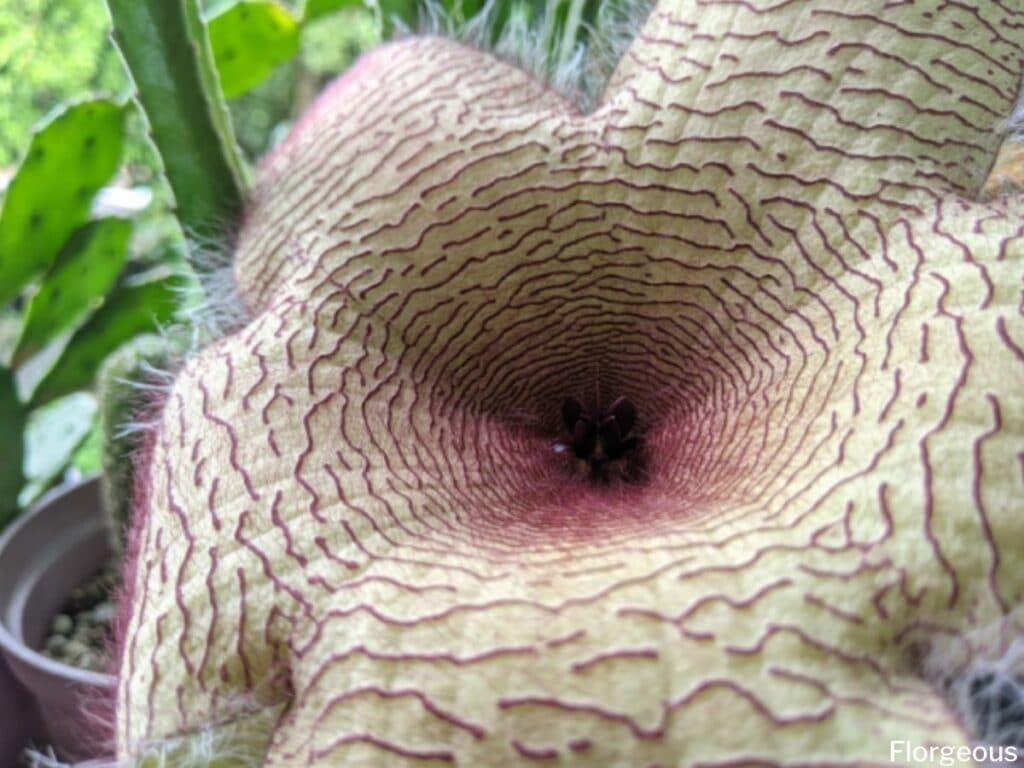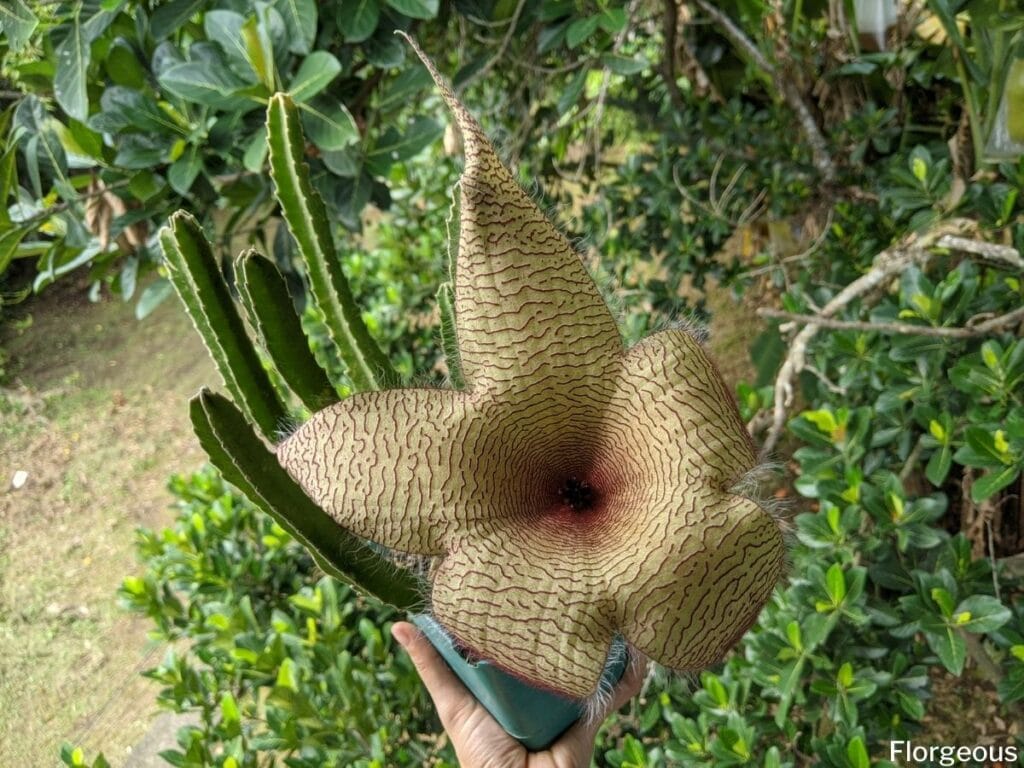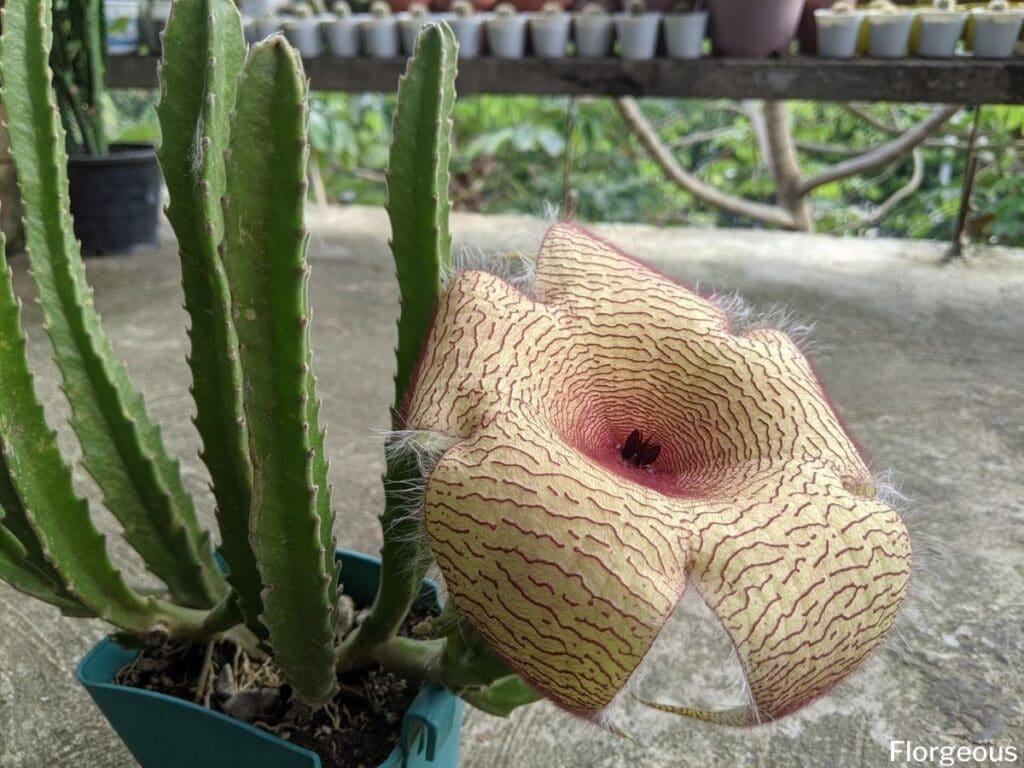With their foul, rotting meat smell, Stapelia plants have the reputation of being one of the most distasteful of flowering plants. But do not let this smelly fact keep you from adding them to your plant collection.
They make up for their foul odor with their stunning and gorgeous blooms. And to add to their beauty, these peculiar succulents are quite easy to care for.
Learn how to make the most out of your Stapelia plant with these caring tips.
What is a Stapelia?
Stapelia is a genus of succulent plants from the dogbane family, Apocynaceae. It is a large genus, with over 50 species. These plants are commonly known as Starfish Flowers or Carrion plants.
They have origins in Eastern and Southern Africa, where they thrive in dry and arid environments. In the wild, they can be seen growing in nooks and corners, underneath bushes, and sometimes hanging on a rocky precipice (1).

Like most succulent Carrion plants are low-growing, green, and fleshy. They grow upright from the soil in dense clumps. Their four-angled stems are leafless with blunt ‘teeth’ running along its length.
Under the strong sunlight, the erect stems will develop a reddish color. These characteristics of Stapelia often lead them to be mistaken for Euphorbia or other cactuses, but they are in fact more related to Hoya plants.
These stapelia flowers bloom in fall. Compared to their stems, the solitary flowers are very showy with sizes ranging from 1-inch to 12-inches in diameter (2). The flowers themselves are hairy, and star shaped. They vary in color from pale yellow with thin red stripes to almost completely crimson.
The curious thing about these star shaped flowers is their smell. Carrion plants, also called carrion flowers, emit a malodorous aroma comparable to the smell of rotting flesh when their flowers open. This smell attracts flies which helps in pollination (3). Each bloom lasts for a week at which time they will start to become floppy and then fall off the plant.
Do all Stapelia Smell Bad?
The answer is no. While most Stapelia plants are characterized as having a foul odor, the smell can still vary from species to species. Larger species can emit a more noticeable rotting odor while smaller species only have the subtle smell. Some species can even be fragrant (4).

Popular Types of Stapelia
The genus harbors over 50 species and every single one of them is beautiful but some of them stand out more than the other. Here are some of the popular starfish succulent species you may want to get your hands on.
Stapelia hirsuta
This species has a very hairy, dark red flower that blooms to a width of 2-6 inches. It is extremely variable with several subspecies and hybrids.
Stapelia grandiflora
This carrion plant features a dark red to deep purple flower with purplish hairs. The starfish cactus flower has a span of 1-5 inches in diameter.
Stapelia gigantea
Also known as the Zulu giant plant, this stapelia gigantea species has one of the largest blooms with flowers reaching a span of up to 9 inches in diameter. The flowers themselves are stunning with yellow and red coloration and hairy margins.
Stapelia scitula
In contrast to S. gigantea, this species has one of the smallest blooms with its dark red flowers only reaching up to 3 inches in diameter.
Stapelia leendertziae
Also known as Black bells, this species features a very distinctive campanulate flower with a deep maroon color.
Stapelia flavopurpurea
The outlier from the group, this species is the most unusual with its small green flowers that smells of beeswax instead of the usual rotting meat.

How to Care for Starfish Cactus
While Stapelia plants are relatively easy to grow, their growth requirements can still vary from one species to another. Some species can require more care than others and can prove to be challenging but the general care is still the same.
Read these Stapelia care tips to learn how to keep these unusual plants thriving beautifully.
Light
Stapelias thrive in regions with intense sunlight. While many can survive in full sun conditions, they often grow under the protection of other plants that filter the extreme midday sun in their natural habitat.
As houseplants, they need bright indirect light to flourish. If you move them outdoors, provide morning or late afternoon sun, but ensure some protection from the most intense sunlight during the day. A red or purple hue on the stems is a sign of sunburn, although it’s not harmful to the plant.
Water
Water Stapelia plants sparingly, allowing the soil to dry out almost completely between waterings. During the growing season (spring and summer), water them when the top inch of soil feels dry to the touch.
Reduce watering frequency in fall and winter when growth slows down. Avoid overwatering, as this can lead to root rot.
Temperature and humidity
Maintain warm temperatures for Stapelia plants, ideally between 70°F to 85°F (21°C to 29°C) during the day and slightly cooler at night. They can tolerate temperatures as low as 50°F (10°C) but should be protected from frost. Stapelia plants prefer low to moderate humidity levels, making them well-suited for indoor environments.
Potting/growing media
Stapelia plants require well-draining soil to prevent waterlogged roots and rot. Use a cactus or succulent potting mix or create your own by mixing equal parts of succulent soil, perlite, and coarse sand. Avoid using regular potting soil, as it retains too much moisture.
Fertilizer
Fertilize Stapelia plants sparingly during the growing season with a balanced, water-soluble fertilizer diluted to half strength. Apply the fertilizer once a month to provide essential nutrients for healthy growth and flowering. Avoid fertilizing during the dormant period in the fall and winter.
Propagation
Stapelia plants can be propagated easily through stem cuttings. Simply cut a healthy stem from the parent plant, allow it to callous for a few days, then plant it in well-draining soil. Keep the soil lightly moist until roots develop, then treat the cutting as a mature plant.
Common pests and diseases
Stapelia plants are relatively pest-resistant but can occasionally attract common succulent pests such as mealybugs, aphids, and spider mites. Inspect your plants regularly for signs of pest infestation, such as webbing, sticky residue, or distorted growth, and treat any issues promptly with insecticidal soap or neem oil.
Additionally, ensure good air circulation around the plants to prevent fungal diseases like black stem rot.
FAQs
How do you get Stapelia to bloom?
To encourage Stapelia to bloom, provide it with bright, indirect sunlight and maintain warm temperatures. Additionally, allow the soil to dry out between waterings during the active growing season, and avoid overfertilizing, as too much nitrogen can inhibit flowering.
Is Stapelia a cactus or succulent?
Stapelia is a succulent plant, not a cactus. It belongs to the Apocynaceae family and is native to southern Africa. Unlike cacti, which typically have spines and are adapted to arid environments, Stapelia species have fleshy stems and are adapted to semi-arid to arid conditions.
What kind of soil does Stapelia need?
Stapelia plants require a well-draining soil mix tailored for succulents or cacti. A mixture of potting soil, perlite, and sand or pumice works well. This type of soil allows excess water to drain away quickly, preventing root rot and other issues associated with overly wet conditions.
How often should I water my Stapelia?
Water your Stapelia sparingly, allowing the soil to dry out between waterings. During the active growing season in spring and summer, water it thoroughly when the top inch of soil feels dry. Reduce watering frequency in the fall and winter when growth slows down, but continue to monitor soil moisture to prevent dehydration. Avoid leaving the soil overly wet, as this can lead to root rot.
Final thoughts
In conclusion, with its unique appearance, interesting flowers, and relatively easy care requirements, the stapelia plant is a delightful addition to any collection, especially for plant enthusiasts.
By following these stapelia plant care tips, you can ensure your succulent thrives and rewards you with its captivating blooms for years to come. Remember, the key lies in providing ample sunlight, well-draining soil, and mindful watering practices. With a little love and attention, your stapelia plant will surely flourish.
Don’t forget to check our list of cactus plants to grow.
References
References
(1) Cohen A., Hammel T., Rindlisbacher J. ‘Mary Elizabeth Barber: Growing Wils: The Correspondence of a Pioneering Woman Naturalist from the Cape.‘ Basler Afrika Bibliographien. 2020. P. 209.
(2) Anon. ‘A Collection of Articles on Indoor Cacti – A Guide to Growing and Care’. Read Books Ltd., 2016.
(3) Baldwin D.L. ‘Succulent Container Gardens: Design Eye-Catching Displays With 350 Easy-Care Plants’. 2010. Timber Press. P. 129.
Close






